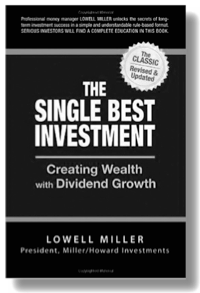Book review - The Single Best Investment: Creating Wealth With Dividend Growth, 2nd ed.
 One of the reviewers on the dust jacket of this book writes “Frankly, I hope he’s not giving away too many secrets.” The book really has that feel, but actually there are no secrets, just many hard facts that Miller doesn’t soften or back away from. I quote some below.
One of the reviewers on the dust jacket of this book writes “Frankly, I hope he’s not giving away too many secrets.” The book really has that feel, but actually there are no secrets, just many hard facts that Miller doesn’t soften or back away from. I quote some below.
Bonds are bad investments. Bonds aren’t investments, they’re savings. In any given period the chances are that bonds won’t beat inflation. The best long-term investment is one where you have the fullest confidence that it will fluctuate back up after it fluctuates down. The right long-term investment will be one that becomes more attractive to you as it declines. A strong holder, and one who can buy declines, will always stand a better chance of success than one whose investment life is governed by the fear of loss. The best long-term investment has something about it that builds confidence in the long-term future. We don’t need to try to get more than the historical average; reasonable goals are attainable, fantasies are not. A common-sense approach to investing dictates against trying to hit home runs. The tortoise beats the hare.
Miller’s “Single Best Investment” (SBI) strategy is about being a partner in a successful enterprise and in harnessing compounding through the combined power of growth and time. Time in investing is your friend, but you will need to learn patience. Find a business with reliable growth that will share that growth with its owners, be patient, and watch it grow. Build a private compounding machine, then let the machine do its work. Dividend income should be reinvested wherever possible but it’s dividend growth that unlocks the magic of compounding, the hidden key to the SBI. Compounding through reinvestment of the dividend has astronomical effects. Dividend growth not only increases income over time, but it drives up the value of the stock. Dividend growth is the true signal of a prospering business. Dividends don’t lie; dividend growth doesn’t lie. (Actually, both can through balance sheet manipulation but they’ll be caught out.) Stocks will rise as much as their dividend rises.
 Miller’s SBI approach is a conservative and risk-averse investment strategy that relies on the formula of finding stocks of high quality with high current dividend and high dividend growth. A chapter discusses the attributes of high quality equities, but these can be recognized through consistent moderate growth, consistent yield and consistent yield growth, the latter at least higher than inflation plus a margin for safety. Although “quality is always a bargain”, there’s a useful discussion of traditional valuation tools (i.e. price-sales, price-earnings, price-book, price-cash flow, etc). I loved his chapter on “undervalued” stocks and the “story” behind a company. In Miller’s view there’s a difference between a company being a genuinely undervalued bargain (which he thinks is unlikely since it’s worth now whatever people are prepared to pay for it) and the belief that the company will do better in the future, which is a story of many parts that will unfold over time. Miller’s SBI story companies make products or services that are necessities so that they produce a predictable stream of cash over many years. Did you ever decide not to pay your electricity bill?
Miller’s SBI approach is a conservative and risk-averse investment strategy that relies on the formula of finding stocks of high quality with high current dividend and high dividend growth. A chapter discusses the attributes of high quality equities, but these can be recognized through consistent moderate growth, consistent yield and consistent yield growth, the latter at least higher than inflation plus a margin for safety. Although “quality is always a bargain”, there’s a useful discussion of traditional valuation tools (i.e. price-sales, price-earnings, price-book, price-cash flow, etc). I loved his chapter on “undervalued” stocks and the “story” behind a company. In Miller’s view there’s a difference between a company being a genuinely undervalued bargain (which he thinks is unlikely since it’s worth now whatever people are prepared to pay for it) and the belief that the company will do better in the future, which is a story of many parts that will unfold over time. Miller’s SBI story companies make products or services that are necessities so that they produce a predictable stream of cash over many years. Did you ever decide not to pay your electricity bill?
Among other aspects of choosing an SBI he looks for a “growth kicker”; solid and seasoned defensive companies often have successful subsidiaries that evolve from their basic solid business. I love his attitude that an investor should have the generosity of spirit to have faith that the management of the companies in which he or she is a passive investor will do their job competently. The SBI investor understands that he or she is a passive owner in a dynamic and complex entity engaged with the real world, not just an investor in a name with a number that bounces up and down every day. The chapter on attitude, on how to hold and how to sell, is alone worth the price of this great book, as is his iconoclastic and forthright chapter on investment allocation. What’s happening to the dividend, and how it’s growing is a critical part of the SBI analysis about holding. Stocks are bought for yield and growth in yield.
Maybe investing is just too tough, too nerve-wracking, too uncertain. Why not just buy a dividend-paying and growing ETF, and forget it? It’s actually hard to find ETFs based on these principles; they’re susceptible to manipulation by their designers and there’s no track record. For those who want to concentrate on the tried-and-true formula of quality plus dividend plus dividend growth, this book is really all you need to know. It’s packed with hard-earned investing wisdom and insights, and provides the disciplined mind-set and solid roadmap necessary for success. Just be patient.
John Prescott is coordinator of the Guelph Share Club

